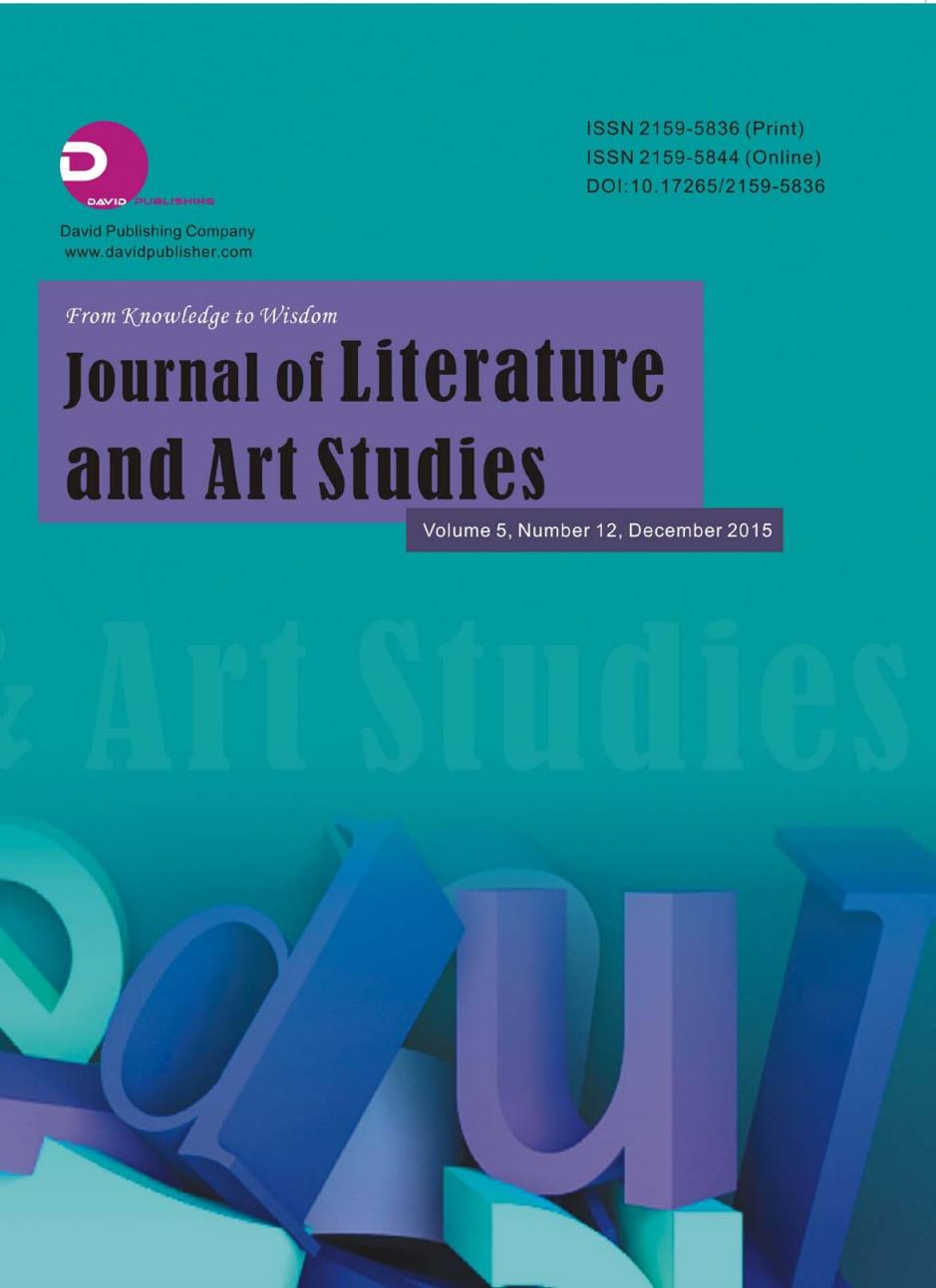
ISSN 2159-5836(Print) D ISSN 2159-5844(Online) D01:10.17265/2159-5836 DAVID David Publishing Company www.davidpublisher.com From Knowledge to Wisdom Journal of Literature and art studies Volume 5,Number 12,December 2015 Art studies
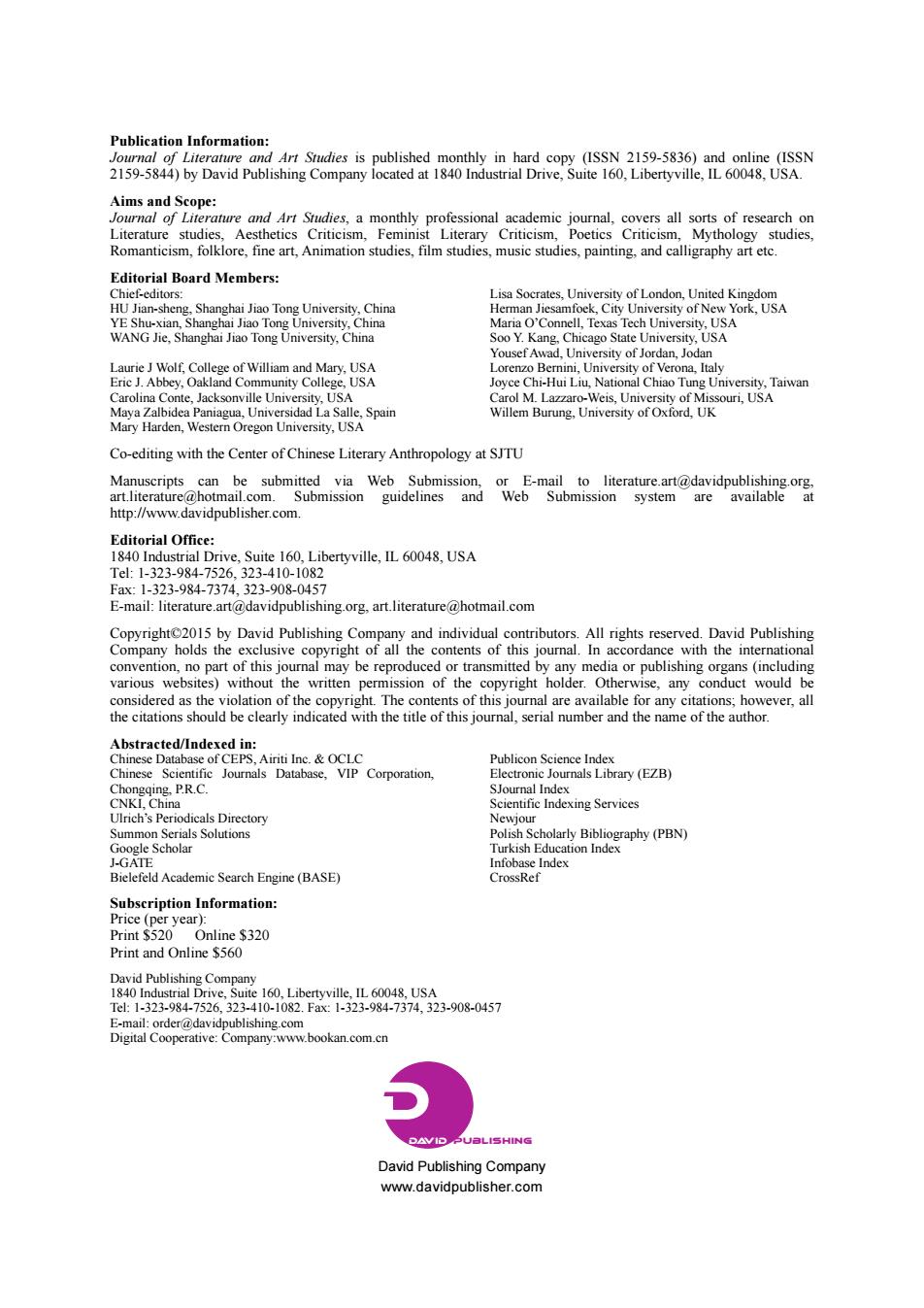
Publication Information: Journal of Literature and Art Studies is published monthly in hard copy (ISSN 2159-5836)and online (ISSN 2159-5844)by David Publishing Company located at 1840 Industrial Drive,Suite 160.Libertyville,IL 60048.USA. Aims and Scope: Journal of Literature and Art Studies,a monthly professional academic journal,covers all sorts of research on Literature studies,Aesthetics Criticism,Feminist Literary Criticism,Poetics Criticism,Mythology studies, Romanticism,folklore,fine art.Animation studies,film studies,music studies,painting,and calligraphy art etc. Editorial Board Members: Chief-editors: Lisa Socrates,University of London,United Kingdom HU Jian-sheng,Shanghai Jiao Tong University,China Herman Jiesamfoek,City University of New York,USA YE Shu-xian,Shanghai Jiao Tong University,China Maria O'Connell,Texas Tech University,USA WANG Jie,Shanghai Jiao Tong University,China Soo Y.Kang,Chicago State University,USA Yousef Awad.University of Jordan,Jodan Laurie J Wolf,College of William and Mary,USA Lorenzo Bernini,University of Verona,Italy Eric J.Abbey,Oakland Community College,USA Joyce Chi-Hui Liu,National Chiao Tung University,Taiwan Carolina Conte,Jacksonville University,USA Carol M.Lazzaro-Weis,University of Missouri,USA Maya Zalbidea Paniagua,Universidad La Salle,Spain Willem Burung,University of Oxford,UK Mary Harden,Western Oregon University,USA Co-editing with the Center of Chinese Literary Anthropology at SJTU Manuscripts can be submitted via Web Submission,or E-mail to literature.art@davidpublishing.org. art.literature@hotmail.com.Submission guidelines and Web Submission system are available at http://www.davidpublisher.com. Editorial Office: 1840 Industrial Drive,Suite 160,Libertyville,IL 60048,USA Te:1-323-984-7526.323-410-1082 Fax:1-323-984-7374.323-908-0457 E-mail:literature.art@davidpublishing.org,art.literature@hotmail.com Copyright 2015 by David Publishing Company and individual contributors.All rights reserved.David Publishing Company holds the exclusive copyright of all the contents of this journal.In accordance with the international convention,no part of this journal may be reproduced or transmitted by any media or publishing organs(including various websites)without the written permission of the copyright holder.Otherwise,any conduct would be considered as the violation of the copyright.The contents of this journal are available for any citations;however,all the citations should be clearly indicated with the title of this journal,serial number and the name of the author. Abstracted/Indexed in: Chinese Database of CEPS,Airiti Inc.OCLC Publicon Science Index Chinese Scientific Journals Database,VIP Corporation, Electronic Journals Library (EZB) Chongqing,P.R.C. SJournal Index CNKI,China Scientific Indexing Services Ulrich's Periodicals Directory Newjour Summon Serials Solutions Polish Scholarly Bibliography (PBN) Google Scholar Turkish Education Index J-GATE Infobase Index Bielefeld Academic Search Engine (BASE) CrossRef Subscription Information: Price(per year): Print $520 Online $320 Print and Online $560 David Publishing Company 1840 Industrial Drive,Suite 160,Libertyville,IL 60048,USA Tel:1-323-984-7526,323-410-1082.Fax:1-323-984-7374,323-908-0457 E-mail:order@davidpublishing.com Digital Cooperative:Company:www.bookan.com.cn OAVD PUBLISHING David Publishing Company www.davidpublisher.com
Publication Information: Journal of Literature and Art Studies is published monthly in hard copy (ISSN 2159-5836) and online (ISSN 2159-5844) by David Publishing Company located at 1840 Industrial Drive, Suite 160, Libertyville, IL 60048, USA. Aims and Scope: Journal of Literature and Art Studies, a monthly professional academic journal, covers all sorts of research on Literature studies, Aesthetics Criticism, Feminist Literary Criticism, Poetics Criticism, Mythology studies, Romanticism, folklore, fine art, Animation studies, film studies, music studies, painting, and calligraphy art etc. Editorial Board Members: Chief-editors: HU Jian-sheng, Shanghai Jiao Tong University, China YE Shu-xian, Shanghai Jiao Tong University, China WANG Jie, Shanghai Jiao Tong University, China Laurie J Wolf, College of William and Mary, USA Eric J. Abbey, Oakland Community College, USA Carolina Conte, Jacksonville University, USA Maya Zalbidea Paniagua, Universidad La Salle, Spain Mary Harden, Western Oregon University, USA Lisa Socrates, University of London, United Kingdom Herman Jiesamfoek, City University of New York, USA Maria O’Connell, Texas Tech University, USA Soo Y. Kang, Chicago State University, USA Yousef Awad, University of Jordan, Jodan Lorenzo Bernini, University of Verona, Italy Joyce Chi-Hui Liu, National Chiao Tung University, Taiwan Carol M. Lazzaro-Weis, University of Missouri, USA Willem Burung, University of Oxford, UK Co-editing with the Center of Chinese Literary Anthropology at SJTU Manuscripts can be submitted via Web Submission, or E-mail to literature.art@davidpublishing.org, art.literature@hotmail.com. Submission guidelines and Web Submission system are available at http://www.davidpublisher.com. Editorial Office: 1840 Industrial Drive, Suite 160, Libertyville, IL 60048, USA Tel: 1-323-984-7526, 323-410-1082 Fax: 1-323-984-7374, 323-908-0457 E-mail: literature.art@davidpublishing.org, art.literature@hotmail.com Copyright©2015 by David Publishing Company and individual contributors. All rights reserved. David Publishing Company holds the exclusive copyright of all the contents of this journal. In accordance with the international convention, no part of this journal may be reproduced or transmitted by any media or publishing organs (including various websites) without the written permission of the copyright holder. Otherwise, any conduct would be considered as the violation of the copyright. The contents of this journal are available for any citations; however, all the citations should be clearly indicated with the title of this journal, serial number and the name of the author. Abstracted/Indexed in: Chinese Database of CEPS, Airiti Inc. & OCLC Chinese Scientific Journals Database, VIP Corporation, Chongqing, P.R.C. CNKI, China Ulrich’s Periodicals Directory Summon Serials Solutions Google Scholar J-GATE Bielefeld Academic Search Engine (BASE) Publicon Science Index Electronic Journals Library (EZB) SJournal Index Scientific Indexing Services Newjour Polish Scholarly Bibliography (PBN) Turkish Education Index Infobase Index CrossRef Subscription Information: Price (per year): Print $520 Online $320 Print and Online $560 David Publishing Company 1840 Industrial Drive, Suite 160, Libertyville, IL 60048, USA Tel: 1-323-984-7526, 323-410-1082. Fax: 1-323-984-7374, 323-908-0457 E-mail: order@davidpublishing.com Digital Cooperative: Company:www.bookan.com.cn David Publishing Company www.davidpublisher.com DDAVID PUBLISHING
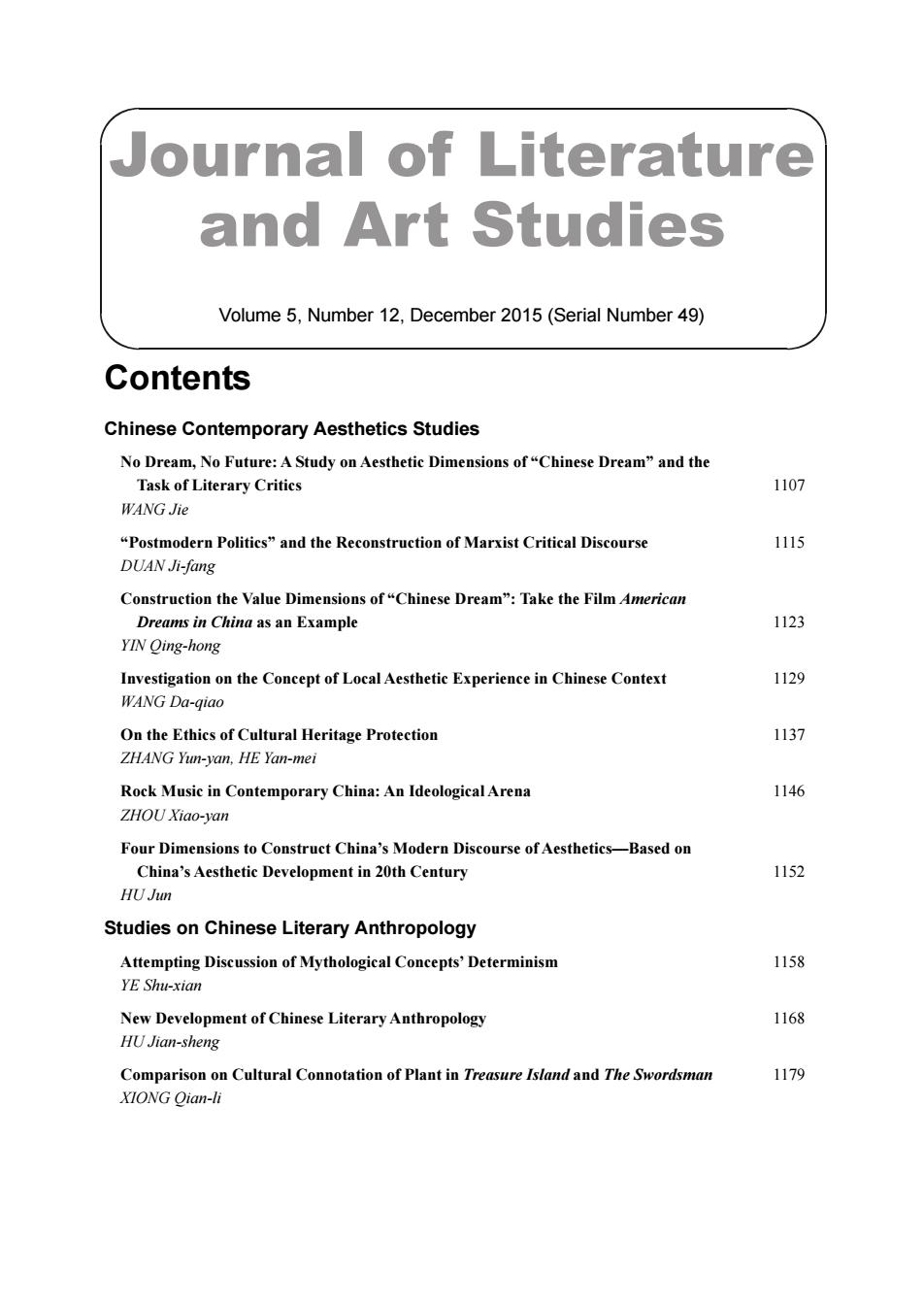
Journal of Literature and Art Studies Volume 5,Number 12,December 2015(Serial Number 49) Contents Chinese Contemporary Aesthetics Studies No Dream,No Future:A Study on Aesthetic Dimensions of"Chinese Dream"and the Task of Literary Critics 1107 WANG Jie "Postmodern Politics"and the Reconstruction of Marxist Critical Discourse 1115 DUAN Ji-fang Construction the Value Dimensions of "Chinese Dream":Take the Film American Dreams in China as an Example 1123 YIN Oing-hong Investigation on the Concept of Local Aesthetic Experience in Chinese Context 1129 WANG Da-giao On the Ethics of Cultural Heritage Protection 1137 ZHANG Yun-yan,HE Yan-mei Rock Music in Contemporary China:An Ideological Arena 1146 ZHOU Xiao-yan Four Dimensions to Construct China's Modern Discourse of Aesthetics-Based on China's Aesthetic Development in 20th Century 1152 HUJun Studies on Chinese Literary Anthropology Attempting Discussion of Mythological Concepts'Determinism 1158 YE Shu-xian New Development of Chinese Literary Anthropology 1168 HU Jian-sheng Comparison on Cultural Connotation of Plant in Treasure Island and The Swordsman 1179 XIONG Qian-li
Journal of Literature and Art Studies Volume 5, Number 12, December 2015 (Serial Number 49) Contents Chinese Contemporary Aesthetics Studies No Dream, No Future: A Study on Aesthetic Dimensions of “Chinese Dream” and the Task of Literary Critics 1107 WANG Jie “Postmodern Politics” and the Reconstruction of Marxist Critical Discourse 1115 DUAN Ji-fang Construction the Value Dimensions of “Chinese Dream”: Take the Film American Dreams in China as an Example 1123 YIN Qing-hong Investigation on the Concept of Local Aesthetic Experience in Chinese Context 1129 WANG Da-qiao On the Ethics of Cultural Heritage Protection 1137 ZHANG Yun-yan, HE Yan-mei Rock Music in Contemporary China: An Ideological Arena 1146 ZHOU Xiao-yan Four Dimensions to Construct China’s Modern Discourse of Aesthetics—Based on China’s Aesthetic Development in 20th Century 1152 HU Jun Studies on Chinese Literary Anthropology Attempting Discussion of Mythological Concepts’ Determinism 1158 YE Shu-xian New Development of Chinese Literary Anthropology 1168 HU Jian-sheng Comparison on Cultural Connotation of Plant in Treasure Island and The Swordsman 1179 XIONG Qian-li
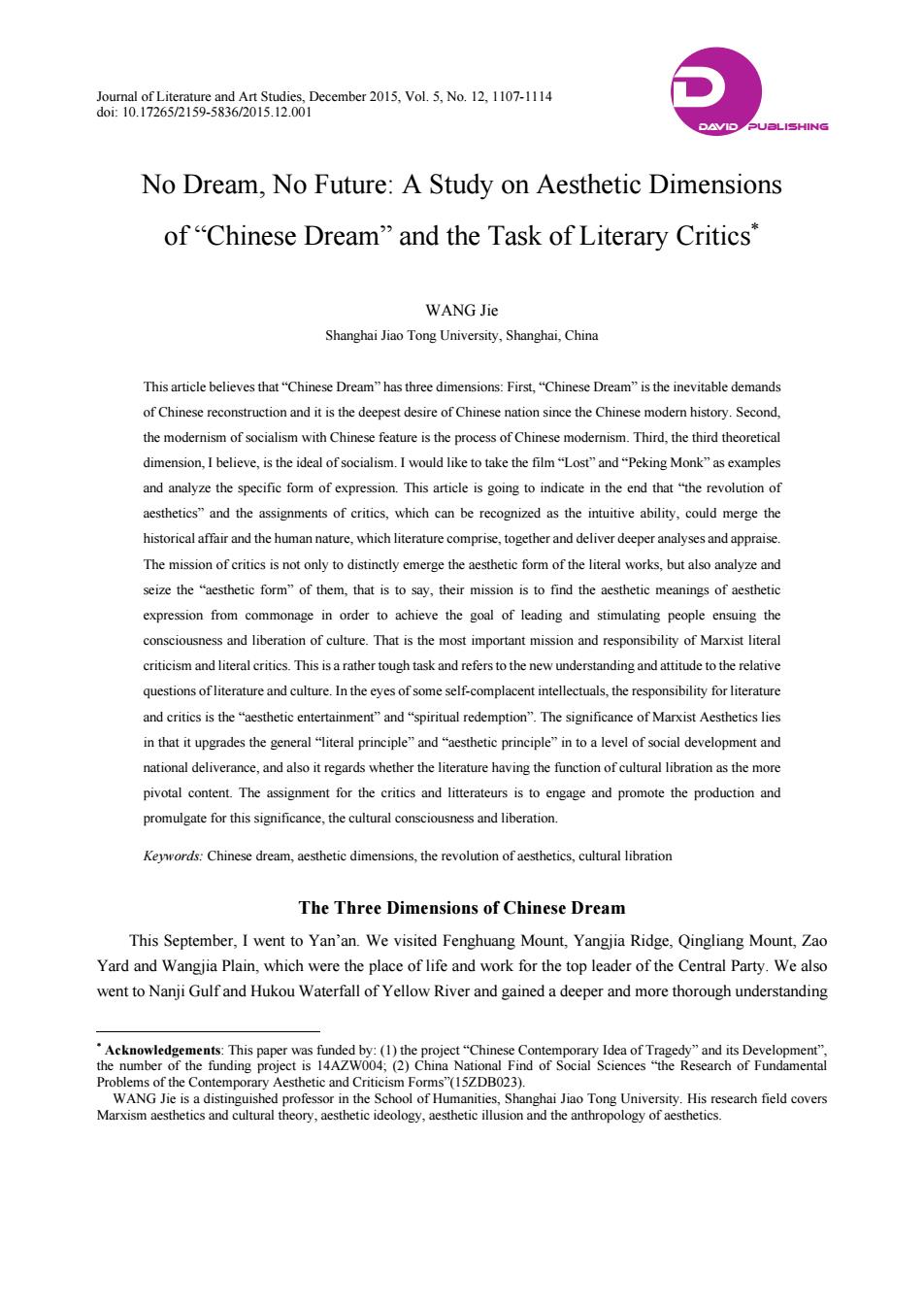
Journal of Literature and Art Studies,December 2015,Vol.5,No.12.1107-1114 doi:10.17265/2159-5836/2015.12.001 DAVD PUBLISHING No Dream,No Future:A Study on Aesthetic Dimensions of"Chinese Dream"and the Task of Literary Critics" WANG Jie Shanghai Jiao Tong University,Shanghai,China This article believes that"Chinese Dream"has three dimensions:First,"Chinese Dream"is the inevitable demands of Chinese reconstruction and it is the deepest desire of Chinese nation since the Chinese modern history.Second, the modernism of socialism with Chinese feature is the process of Chinese modernism.Third,the third theoretical dimension,I believe,is the ideal of socialism.I would like to take the film"Lost"and"Peking Monk"as examples and analyze the specific form of expression.This article is going to indicate in the end that"the revolution of aesthetics"and the assignments of critics,which can be recognized as the intuitive ability,could merge the historical affair and the human nature,which literature comprise,together and deliver deeper analyses and appraise. The mission of critics is not only to distinctly emerge the aesthetic form of the literal works,but also analyze and seize the "aesthetic form"of them,that is to say,their mission is to find the aesthetic meanings of aesthetic expression from commonage in order to achieve the goal of leading and stimulating people ensuing the consciousness and liberation of culture.That is the most important mission and responsibility of Marxist literal criticism and literal critics.This is a rather tough task and refers to the new understanding and attitude to the relative questions of literature and culture.In the eyes of some self-complacent intellectuals,the responsibility for literature and critics is the"aesthetic entertainment"and"spiritual redemption".The significance of Marxist Aesthetics lies in that it upgrades the general"literal principle"and"aesthetic principle"in to a level of social development and national deliverance,and also it regards whether the literature having the function of cultural libration as the more pivotal content.The assignment for the critics and litterateurs is to engage and promote the production and promulgate for this significance,the cultural consciousness and liberation Kewwords:Chinese dream,aesthetic dimensions,the revolution of aesthetics,cultural libration The Three Dimensions of Chinese Dream This September,I went to Yan'an.We visited Fenghuang Mount,Yangjia Ridge,Qingliang Mount,Zao Yard and Wangjia Plain,which were the place of life and work for the top leader of the Central Party.We also went to Nanji Gulf and Hukou Waterfall of Yellow River and gained a deeper and more thorough understanding Acknowledgements:This paper was funded by:(1)the project"Chinese Contemporary Idea of Tragedy"and its Development", the number of the funding project is 14AZW004;(2)China National Find of Social Sciences "the Research of Fundamental Problems of the Contemporary Aesthetic and Criticism Forms"(15ZDB023). WANG Jie is a distinguished professor in the School of Humanities,Shanghai Jiao Tong University.His research field covers Marxism aesthetics and cultural theory,aesthetic ideology,aesthetic illusion and the anthropology of aesthetics
Journal of Literature and Art Studies, December 2015, Vol. 5, No. 12, 1107-1114 doi: 10.17265/2159-5836/2015.12.001 No Dream, No Future: A Study on Aesthetic Dimensions of “Chinese Dream” and the Task of Literary Critics WANG Jie Shanghai Jiao Tong University, Shanghai, China This article believes that “Chinese Dream” has three dimensions: First, “Chinese Dream” is the inevitable demands of Chinese reconstruction and it is the deepest desire of Chinese nation since the Chinese modern history. Second, the modernism of socialism with Chinese feature is the process of Chinese modernism. Third, the third theoretical dimension, I believe, is the ideal of socialism. I would like to take the film “Lost” and “Peking Monk” as examples and analyze the specific form of expression. This article is going to indicate in the end that “the revolution of aesthetics” and the assignments of critics, which can be recognized as the intuitive ability, could merge the historical affair and the human nature, which literature comprise, together and deliver deeper analyses and appraise. The mission of critics is not only to distinctly emerge the aesthetic form of the literal works, but also analyze and seize the “aesthetic form” of them, that is to say, their mission is to find the aesthetic meanings of aesthetic expression from commonage in order to achieve the goal of leading and stimulating people ensuing the consciousness and liberation of culture. That is the most important mission and responsibility of Marxist literal criticism and literal critics. This is a rather tough task and refers to the new understanding and attitude to the relative questions of literature and culture. In the eyes of some self-complacent intellectuals, the responsibility for literature and critics is the “aesthetic entertainment” and “spiritual redemption”. The significance of Marxist Aesthetics lies in that it upgrades the general “literal principle” and “aesthetic principle” in to a level of social development and national deliverance, and also it regards whether the literature having the function of cultural libration as the more pivotal content. The assignment for the critics and litterateurs is to engage and promote the production and promulgate for this significance, the cultural consciousness and liberation. Keywords: Chinese dream, aesthetic dimensions, the revolution of aesthetics, cultural libration The Three Dimensions of Chinese Dream This September, I went to Yan’an. We visited Fenghuang Mount, Yangjia Ridge, Qingliang Mount, Zao Yard and Wangjia Plain, which were the place of life and work for the top leader of the Central Party. We also went to Nanji Gulf and Hukou Waterfall of Yellow River and gained a deeper and more thorough understanding Acknowledgements: This paper was funded by: (1) the project “Chinese Contemporary Idea of Tragedy” and its Development”, the number of the funding project is 14AZW004; (2) China National Find of Social Sciences “the Research of Fundamental Problems of the Contemporary Aesthetic and Criticism Forms”(15ZDB023). WANG Jie is a distinguished professor in the School of Humanities, Shanghai Jiao Tong University. His research field covers Marxism aesthetics and cultural theory, aesthetic ideology, aesthetic illusion and the anthropology of aesthetics. D DAVID PUBLISHING
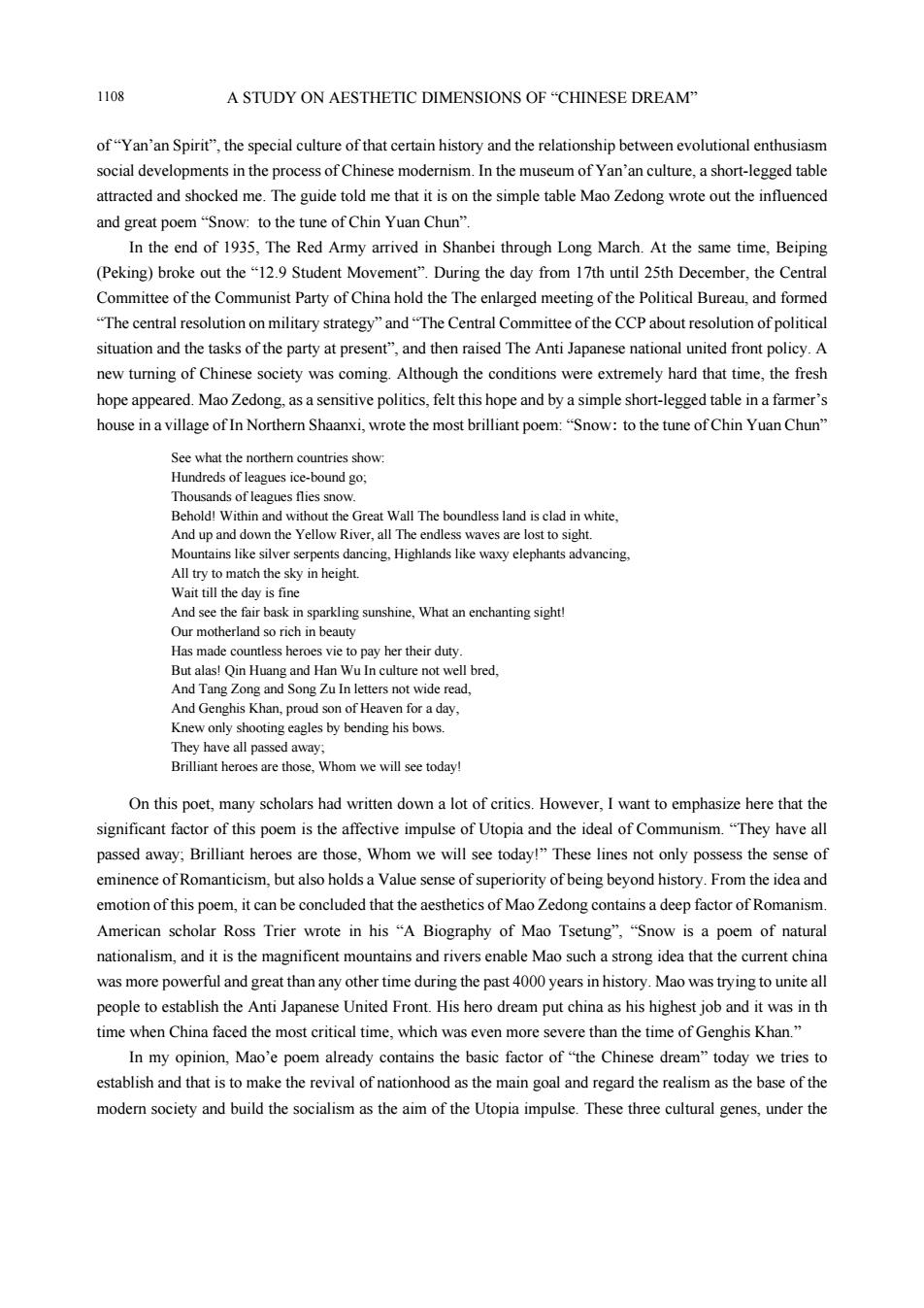
1108 A STUDY ON AESTHETIC DIMENSIONS OFCHINESE DREAM of"Yan'an Spirit",the special culture of that certain history and the relationship between evolutional enthusiasm social developments in the process of Chinese modernism.In the museum of Yan'an culture,a short-legged table attracted and shocked me.The guide told me that it is on the simple table Mao Zedong wrote out the influenced and great poem"Snow:to the tune of Chin Yuan Chun". In the end of 1935,The Red Army arrived in Shanbei through Long March.At the same time,Beiping (Peking)broke out the "12.9 Student Movement".During the day from 17th until 25th December,the Central Committee of the Communist Party of China hold the The enlarged meeting of the Political Bureau,and formed "The central resolution on military strategy"and"The Central Committee of the CCP about resolution of political situation and the tasks of the party at present",and then raised The Anti Japanese national united front policy.A new turning of Chinese society was coming.Although the conditions were extremely hard that time,the fresh hope appeared.Mao Zedong,as a sensitive politics,felt this hope and by a simple short-legged table in a farmer's house in a village of In Northern Shaanxi,wrote the most brilliant poem:"Snow:to the tune of Chin Yuan Chun" See what the northern countries show: Hundreds of leagues ice-bound go; Thousands of leagues flies snow. Behold!Within and without the Great Wall The boundless land is clad in white. And up and down the Yellow River,all The endless waves are lost to sight. Mountains like silver serpents dancing.Highlands like waxy elephants advancing, All try to match the sky in height. Wait till the day is fine And see the fair bask in sparkling sunshine,What an enchanting sight! Our motherland so rich in beauty Has made countless heroes vie to pay her their duty But alas!Qin Huang and Han Wu In culture not well bred, And Tang Zong and Song Zu In letters not wide read, And Genghis Khan,proud son of Heaven for a day, Knew only shooting eagles by bending his bows. They have all passed away; Brilliant heroes are those,Whom we will see today! On this poet,many scholars had written down a lot of critics.However,I want to emphasize here that the significant factor of this poem is the affective impulse of Utopia and the ideal of Communism."They have all passed away;Brilliant heroes are those,Whom we will see today!"These lines not only possess the sense of eminence of Romanticism,but also holds a Value sense of superiority of being beyond history.From the idea and emotion of this poem,it can be concluded that the aesthetics of Mao Zedong contains a deep factor of Romanism. American scholar Ross Trier wrote in his "A Biography of Mao Tsetung","Snow is a poem of natural nationalism,and it is the magnificent mountains and rivers enable Mao such a strong idea that the current china was more powerful and great than any other time during the past 4000 years in history.Mao was trying to unite all people to establish the Anti Japanese United Front.His hero dream put china as his highest job and it was in th time when China faced the most critical time,which was even more severe than the time of Genghis Khan." In my opinion,Mao'e poem already contains the basic factor of"the Chinese dream"today we tries to establish and that is to make the revival of nationhood as the main goal and regard the realism as the base of the modern society and build the socialism as the aim of the Utopia impulse.These three cultural genes,under the
1108 A STUDY ON AESTHETIC DIMENSIONS OF “CHINESE DREAM” of “Yan’an Spirit”, the special culture of that certain history and the relationship between evolutional enthusiasm social developments in the process of Chinese modernism. In the museum of Yan’an culture, a short-legged table attracted and shocked me. The guide told me that it is on the simple table Mao Zedong wrote out the influenced and great poem “Snow: to the tune of Chin Yuan Chun”. In the end of 1935, The Red Army arrived in Shanbei through Long March. At the same time, Beiping (Peking) broke out the “12.9 Student Movement”. During the day from 17th until 25th December, the Central Committee of the Communist Party of China hold the The enlarged meeting of the Political Bureau, and formed “The central resolution on military strategy” and “The Central Committee of the CCP about resolution of political situation and the tasks of the party at present”, and then raised The Anti Japanese national united front policy. A new turning of Chinese society was coming. Although the conditions were extremely hard that time, the fresh hope appeared. Mao Zedong, as a sensitive politics, felt this hope and by a simple short-legged table in a farmer’s house in a village of In Northern Shaanxi, wrote the most brilliant poem: “Snow: to the tune of Chin Yuan Chun” See what the northern countries show: Hundreds of leagues ice-bound go; Thousands of leagues flies snow. Behold! Within and without the Great Wall The boundless land is clad in white, And up and down the Yellow River, all The endless waves are lost to sight. Mountains like silver serpents dancing, Highlands like waxy elephants advancing, All try to match the sky in height. Wait till the day is fine And see the fair bask in sparkling sunshine, What an enchanting sight! Our motherland so rich in beauty Has made countless heroes vie to pay her their duty. But alas! Qin Huang and Han Wu In culture not well bred, And Tang Zong and Song Zu In letters not wide read, And Genghis Khan, proud son of Heaven for a day, Knew only shooting eagles by bending his bows. They have all passed away; Brilliant heroes are those, Whom we will see today! On this poet, many scholars had written down a lot of critics. However, I want to emphasize here that the significant factor of this poem is the affective impulse of Utopia and the ideal of Communism. “They have all passed away; Brilliant heroes are those, Whom we will see today!” These lines not only possess the sense of eminence of Romanticism, but also holds a Value sense of superiority of being beyond history. From the idea and emotion of this poem, it can be concluded that the aesthetics of Mao Zedong contains a deep factor of Romanism. American scholar Ross Trier wrote in his “A Biography of Mao Tsetung”, “Snow is a poem of natural nationalism, and it is the magnificent mountains and rivers enable Mao such a strong idea that the current china was more powerful and great than any other time during the past 4000 years in history. Mao was trying to unite all people to establish the Anti Japanese United Front. His hero dream put china as his highest job and it was in th time when China faced the most critical time, which was even more severe than the time of Genghis Khan.” In my opinion, Mao’e poem already contains the basic factor of “the Chinese dream” today we tries to establish and that is to make the revival of nationhood as the main goal and regard the realism as the base of the modern society and build the socialism as the aim of the Utopia impulse. These three cultural genes, under the